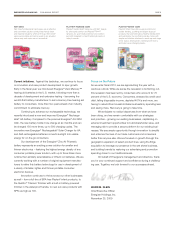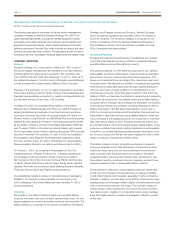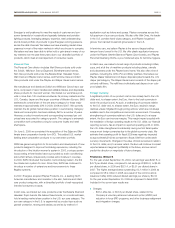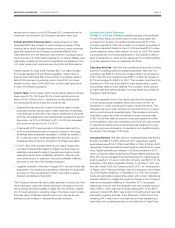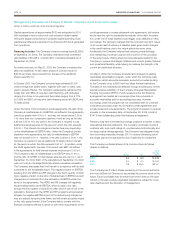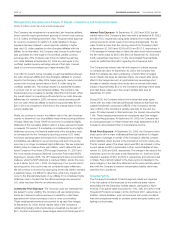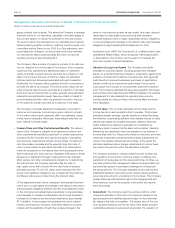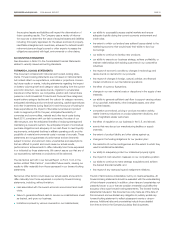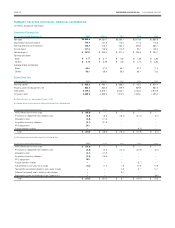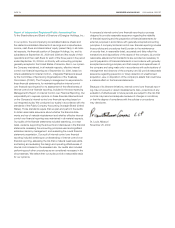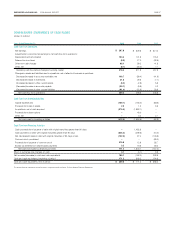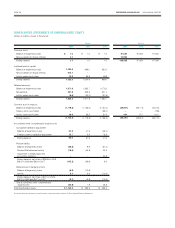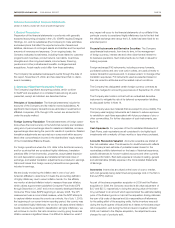Energizer 2009 Annual Report Download - page 21
Download and view the complete annual report
Please find page 21 of the 2009 Energizer annual report below. You can navigate through the pages in the report by either clicking on the pages listed below, or by using the keyword search tool below to find specific information within the annual report.
ENERGIZER HOLDINGS INC. 2009 ANNUAL REPORT PAGE 19
Customer orders for the Company’s Sun Care products are highly
seasonal, which has historically resulted in higher Sun Care sales in
the second and third quarters of our fiscal year and lower sales in the
first and fourth quarters of our fiscal year. As a result, sales, operating
income, working capital and cash flows for the Personal Care segment
can vary significantly between quarters of the same and different years
due to the seasonality of orders for Sun Care products.
Other factors may also have an impact on the timing and amounts of
sales, operating income, working capital and cash flows. They include:
the timing of new product launches by competitors or by the Com-
pany, the timing of advertising, promotional, merchandising or other
marketing activities by competitors or by the Company, and the timing
of retailer merchandising decisions and actions.
Environmental Matters
The operations of the Company, like those of other companies, are subject
to various federal, state, foreign and local laws and regulations intended
to protect the public health and the environment. These regulations relate
primarily to worker safety, air and water quality, underground fuel storage
tanks and waste handling and disposal. The Company has received
notices from the U.S. Environmental Protection Agency, state agencies
and/or private parties seeking contribution, that it has been identified as a
“potentially responsible party” (PRP) under the Comprehensive Environ-
mental Response, Compensation and Liability Act, and may be required
to share in the cost of cleanup with respect to eight federal “Superfund”
sites. It may also be required to share in the cost of cleanup with respect
to state-designated sites or other sites outside of the U.S.
Accrued environmental costs at September 30, 2009 were $9.1, of
which $1.8 is expected to be spent in fiscal 2010. This accrual is not
measured on a discounted basis. It is difficult to quantify with certainty the
cost of environmental matters, particularly remediation and future capital
expenditures for environmental control equipment. Nevertheless, based
on information currently available, the Company believes the possibility of
material environmental costs in excess of the accrued amount is remote.
Inflation
Management recognizes that inflationary pressures may have an
adverse effect on the Company, through higher material, labor and
transportation costs, asset replacement costs and related deprecia-
tion, and other costs. In general, the Company has been able to
offset or minimize inflation effects through other cost reductions and
productivity improvements through mid-2005, thus inflation was not a
significant factor to that point. In recent years, the cost of zinc, nickel,
steel, oil and other commodities used in the Company’s production
and distribution have become more volatile. Looking forward, we
expect commodities, raw materials and other inflationary input costs
for Household Products and Personal Care to be favorable in 2010 as
compared to average costs paid in 2009 by an amount ranging from
$15 to $20 based on current market conditions. We cannot predict
with any degree of certainty the impact of future fluctuations in the
prices of commodities, raw materials and other input costs. In addition,
we cannot predict what, if any, impact the recent economic stimulus
measures may have on inflationary pressures over time.
Critical Accounting Policies
The Company identified the policies below as critical to its business
operations and the understanding of its results of operations. The
impact and any associated risks related to these policies on its busi-
ness operations is discussed throughout Management’s Discussion
and Analysis of Results of Operations and Financial Condition, where
such policies affect the reported and expected financial results.
Preparation of the financial statements in conformity with GAAP in the
U.S. requires the Company to make estimates and assumptions that
affect the reported amounts of assets and liabilities, disclosure of con-
tingent assets and liabilities and the reported amounts of revenues and
expenses. On an ongoing basis, the Company evaluates its estimates,
including those related to customer programs and incentives, product
returns, inventories, intangible assets and other long-lived assets,
income taxes, financing, pensions and other postretirement benefits,
and contingencies. Actual results could differ from those estimates.
This listing is not intended to be a comprehensive list of all of the
Company’s accounting policies.
■ Revenue Recognition The Company’s revenue is from the sale
of its products. Revenue is recognized when title, ownership and
risk of loss pass to the customer. When discounts are offered to
customers for early payment, an estimate of such discounts is
recorded as a reduction of net sales in the same period as the sale.
Standard sales terms are final and, except for seasonal sun care
returns which is discussed in detail in the next paragraph, returns
or exchanges are not permitted unless a special exception is made;
reserves are established and recorded in cases where the right of
return does exist for a particular sale.
Under certain circumstances, we allow customers to return Sun
Care products that have not been sold by the end of the sun care
season, which is normal practice in the sun care industry. We record
sales at the time the title, ownership and risk of loss pass to the
customer. The terms of these sales vary but, in all instances, the
following conditions are met: the sales arrangement is evidenced
by purchase orders submitted by customers; the selling price is
fixed or determinable; title to the product has transferred; there
is an obligation to pay at a specified date without any additional
conditions or actions required by the Company; and collectability is
reasonably assured. Simultaneous with the sale, we reduce sales
and cost of sales, and reserve amounts on our consolidated bal-
ance sheet for anticipated returns based upon an estimated return
level, in accordance with GAAP. Customers are required to pay
for the Sun Care product purchased during the season under the
required terms. Due to the seasonal nature of sun care, we offer a
limited extension of terms to certain qualified customers. This limited
extension requires substantial cash payments prior to or during the
sun care season. We generally receive returns of U.S. Sun Care
products from September through January following the summer
sun care season. We estimate the level of sun care returns using a
variety of inputs including historical experience, consumption trends
during the sun care season and inventory positions at key retailers
as the sun care season progresses. We monitor shipment activity
and inventory levels at key retailers during the season in an effort to


